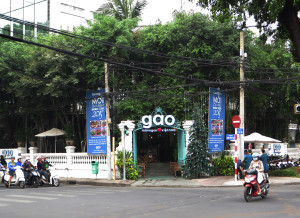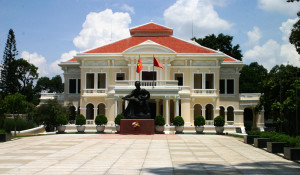
The old Bec villa at 33 Lê Quý Đôn, pictured in December 2011
This article was published previously in Saigoneer
Despite the ongoing destruction of colonial buildings in Saigon, there’s still a small quarter of District 3 where it’s possible to identify villas which were once occupied by rich French rubber planters.
The area of District 3 bordered by Nam Kỳ Khởi Nghĩa, Nguyễn Đình Chiểu, Lê Quý Đôn and Võ Thị Sáu has long been known unofficially as Saigon’s “rubber plantation district.” In the early 20th century, many rich French rubber planters bought or rented homes in this area, close to the Saigon offices of companies like the Société plantations des terres rouges, the Compagnie des Caoutchoucs de Padang, the Compagnie des Caoutchoucs d’An Vieng and the Compagnie des Caoutchoucs de Cambodge.

17 Lê Quý Đôn
All of these offices were located at nearby 236 rue Mac-Mahon, now 236 Nam Kỳ Khởi Nghĩa, an address which even today is still home to the Rubber Research Institute of Việt Nam (Viện Nghiên Cứu Cao Su Việt Nam) and the Việt Nam Rubber Group (Tập Đoàn Công Nghiệp Cao Su Việt Nam).
The French villa at 17 rue Barbé/Barbet, now 17 Lê Quý Đôn, first appears in colonial records in 1923 as the home of Monsieur J Pierret, proprietor of the Société des plantations de Route-haute in Tây Ninh. In 1923-1925, Pierret served as Treasurer of the Union of Indochina Rubber Planters (Syndicat des Planteurs de caoutchouc de l’Indochine). By 1928. he could be found renting another villa (now demolished) at nearby 167 rue Mayer, now Võ Thị Sáu.

The old Bec villa at 33 Lê Quý Đôn, pictured today, completely hidden by trees
During the same period, the villa at 33 rue Barbé/Barbet, now Gạo restaurant at 33 Lê Quý Đôn, was the residence of Monsieur Bec, owner of the plantation An-Nhon. In contrast to number 17, this villa was actually owned by the Bec family, and their crest may still be seen today above the entrance door of the villa. In the early 1950s, the Becs sold the property to King Bảo Đại’s uncle Prince Nguyễn Phúc Bửu Lộc before returning to France.
Further along the same road is another heritage property at 45 rue Barbé/Barbet, now 45 Lê Quý Đôn. In 1924, this was the residence of Monsieur Perot, Director of the Société des plantations de Courtenay, but by 1927 it had become the residence of a senior government administrator named Blanchard.

45 Lê Quý Đôn
While serving as President of the Cochinchina Budget Commission, Monsieur Blanchard was the Director of no fewer than three large rubber plantation companies – the Compagnie des Caoutchoucs de Cambodge, the Compagnie du Caoutchouc Padang, and the Société des plantations des Terres Rouges.
Perhaps the best-known relic of Saigon’s “rubber plantation district” is the grand mansion at 169 rue Mac-Mahon, now the Hồ Chí Minh City Children’s House at 169 Nam Kỳ Khởi Nghĩa. It was built in 1927 for millionaire plantation owner Madame de la Souchère, a larger-then-life character who is often cited as the model for the character of plantation owner Éliane Devries, played by Cathérine Deneuve in Régis Wargnier’s 1992 film Indochine.

The former Souchère mansion at 169 Nam Kỳ Khởi Nghĩa
She built this huge mansion in 1927, but lived there for only three years – in 1930, it was repossessed by the Bank of Indochina after she had lost her entire fortune in the economic crisis. The mansion later became the residence of General Philippe Leclerc (1945-1946), commander of French forces in Indochina after World War II, and in the late 1960s the residence of the Deputy President of the Republic of Việt Nam. In 2015 it underwent a sympathetic renovation.
Like so many other old structures of their kind, these few surviving colonial planter villas are not recognised as heritage buildings and as such their future remains uncertain.
Tim Doling is the author of the guidebook Exploring Saigon-Chợ Lớn – Vanishing heritage of Hồ Chí Minh City (Nhà Xuất Bản Thế Giới, Hà Nội, 2019)
A full index of all Tim’s blog articles since November 2013 is now available here.
Join the Facebook group pages Saigon-Chợ Lớn Then & Now to see historic photographs juxtaposed with new ones taken in the same locations, and Đài Quan sát Di sản Sài Gòn – Saigon Heritage Observatory for up-to-date information on conservation issues in Saigon and Chợ Lớn.

